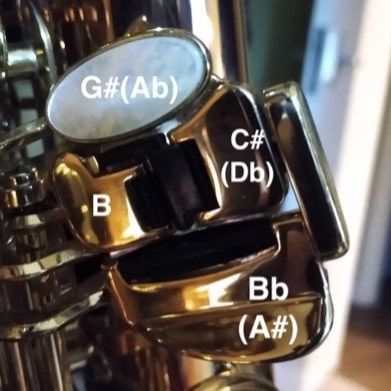Sax players often avoid venturing into the realm of the left-hand ‘paddle’ keys. These are used mainly for the notes below low D. However, those of us who are bari players are pretty familiar with them, ‘paddling in the swamp’, as we do.
Warning: it is highly recommended you read this with your saxophone in your hands!

Out of the four paddle keys, we are all familiar with the top most one giving you a G#(Ab).
The others are C#(Db), B and Bb(A#). What a lot of people don’t know is that, on most modern saxes, they are cleverly linked to make life easier!
The G# link
The G#(Ab) key is one of only two keys on the sax that opens a tone hole rather than closing it (the other is bottom C#). So, if you are playing a G#, you can play any notes below (and their octave higher) without taking your finger off the G# key as it won’t affect the sound by leaving your pinky finger on! When you play other notes (eg. F,E,D) whilst pressing the G# key, the mechanism cleverly closes the G# tone hole for you. In the circled bar below (excerpt from a Stevie Wonder Medley), you can play all four notes whilst the G# paddle is held down continuously, making it much easier to play.

All paddles lead to G#/Ab
Pressing any of the paddle keys (whilst fingering a G) will give you a G#! Yup… hold down G and then press the C# paddle – you get G#, hold down G and the Bb paddle – a G#, and so on. This really helps if you need to move from a G# to any of the low paddle notes, C#, B or Bb. It works the other way, too. The circled bar below shows how you can play the low C# followed by the higher G# just by taking your right-hand fingers off and leaving your pinky finger on the C# paddle! Easy!

Try them out and see if they can help you!





Thank you Matthew. Very useful!!!!!!